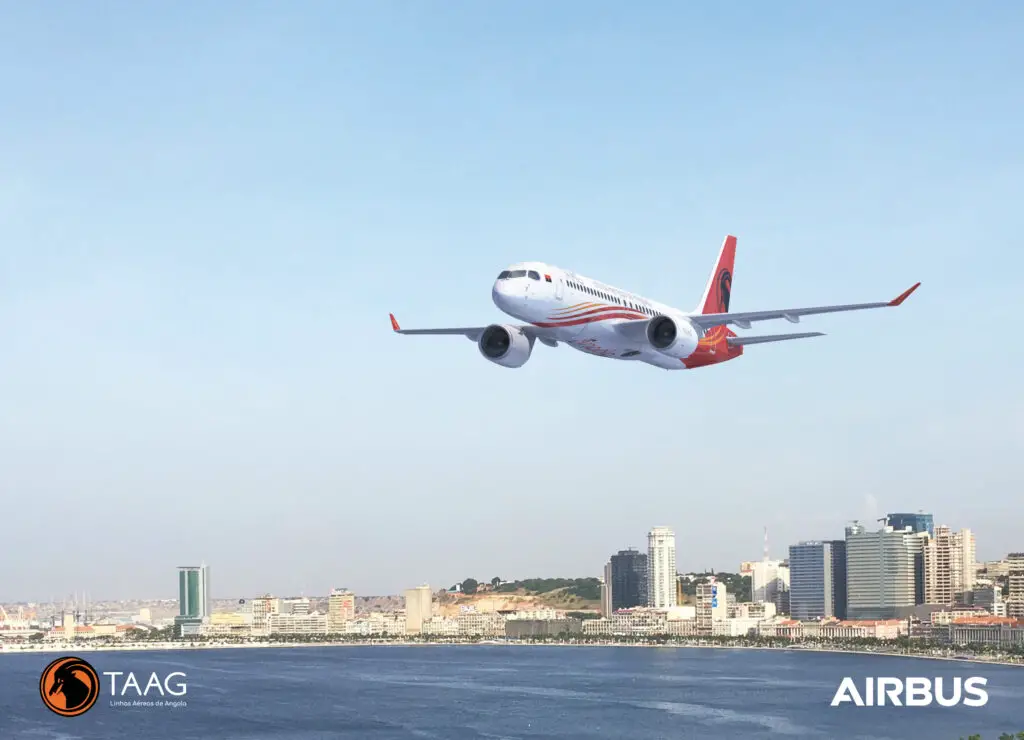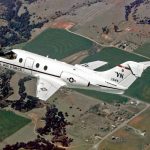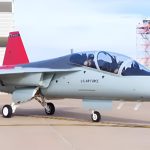One of the highlights of the Farnborough Air Show was definitely the agreement, between Air Lease Corporation (ALC) and TAAG, Angola’s flag carrier, by which the airline will lease six Airbus A220-300.
Beyond all the implications that their transition from Boeing to Airbus in their narrowbody fleet has, this will ultimately represent the end of their shift in TAAG’s short-haul fleet, from a fleet of Boeing 737-700 to De Havilland Canadas Dash 8-400 and Airbus A220-300.
TAAG will now jump from the current five 737-700s — one of which flies exclusively cargo — to a total of six Dash 8 and six A220s.
What could be more puzzling for everyone, both the Dash 8 and A220s will come to replace the 737. How come?
With the help of Cirium’s Diio Mi application, we’ll take a look at TAAG Angola’s network strategy and how the new aircraft will shape it going forward.
Before the Dash 8 arrived
Before the turboprop arrived, TAAG had a problem with its short-haul fleet. Not because of passenger experience — the 737 is arguably more comfortable than the Dash 8 –, but rather because of the economics of the jets, which make shorter routes more difficult to turn a profit in.

The longest domestic route flown by TAAG — Luanda-Ondjiva, at the border with Namibia — can be flown in less than two hours by the Dash 8, while the 737 would do it in 80 minutes. All domestic routes operated by TAAG are shorter than this, so the gap is generally lower. The flight to Cabinda, for instance, has a flight length of 50 minutes for the Dash 8 and 40 minutes with the 737.
More importantly than that, though, is that once you add the Dash 8 into the system, the trip cost is generally reduced by about 30% versus the 737, while carrying 46 passengers less.
But before TAAG managed to find the solution, the financial results of sticking to the 737 were grim. A research by Dedaldino Ventura, a Masters student at Lisbon’s ISEC Higher Education Institute that managed to get a breakdown of TAAG’s domestic routes, says that in 2019, before COVID, Angola’s national airline lost money in all of them.
In short, TAAG’s management knew — and Ventura’s study agreed with it — that swapping the 737s for turboprops in these shorter routes would be the best alternative possible.
Why bringing the turboprops?
Another very important factor of this was that most of TAAG’s domestic routes, connecting the country’s capital to the provinces, do not necessarily count with much demand.
This would mean, according to Ventura’s research, that in a given week, less than 70 passengers would use the routes from Luanda to Kuito and Menongue, even though the flights had a single weekly rotation anyway.
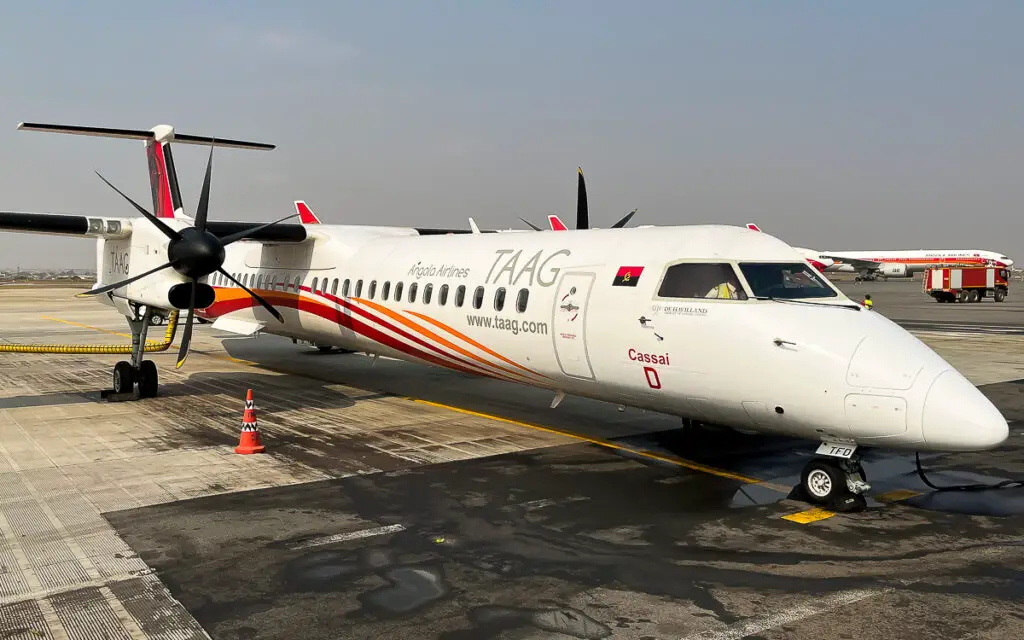
In other words: even if it made sense from a cost point of view, a 737 wasn’t needed in many of TAAG’s internal routes. In fact, on average, seven of the twelve domestic routes from Luanda wouldn’t fill a Dash 8 (that is, load factor was lower than 62%).
Of course, here we’re being very simplistic and considering only the number of seats, ignoring the cost per seat change that the new aircraft would bring, the new fares, demand elasticity and so on. Still, it is a strong indicator that the market needed a smaller aircraft.
Where TAAG stands now
After taking delivery of its first Dash 8 on June 2020, TAAG is currently operating the six aircraft of the type. That, in itself, would be enough to raise the airline’s short-haul fleet by two aircraft, were the Boeings to leave.
Taking a look at TAAG’s July 2022 network with a little help from Cirium, we can see some things have already changed. For instance, all flights now pass by Luanda (tag-ons are over).
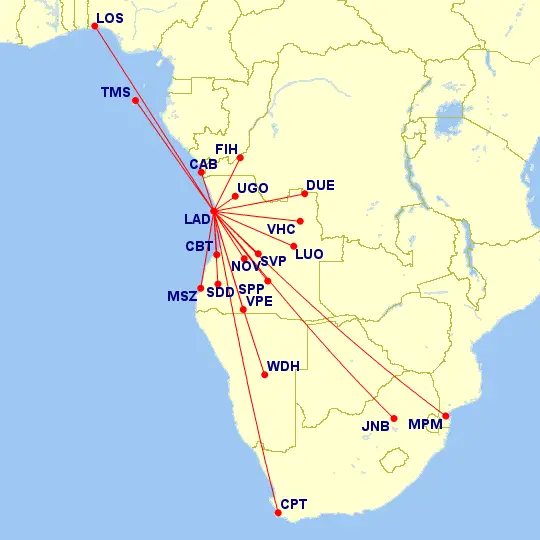
But the effects of the Dash 8 can already be felt by comparing the routes that still didn’t return when comparing July 2022 to July 2019 (shown below in red) and the new ones (shown below in blue).

While the tag-ons were all slashed, two new routes exist: Luanda-Kinshasa — with the stop in Brazzaville not happening anymore — and Luanda-Uíge, a route that was restarted after two decades. These two are kept due to the characteristics of the Dash 8, which has been operating in both.
If we break down TAAG’s current network, the role of the Dash is also clear. At this stage, with the exception of the flights to Cabinda (Angola’s most important domestic route), which also require the 737, all domestic flights are operated by the turboprop.
Regionally, the Dash has also been flying internationally to Kinshasa, as mentioned before, and Windhoek — a flight that reaches almost three and a half hours of flight, versus the 737’s two and a half.
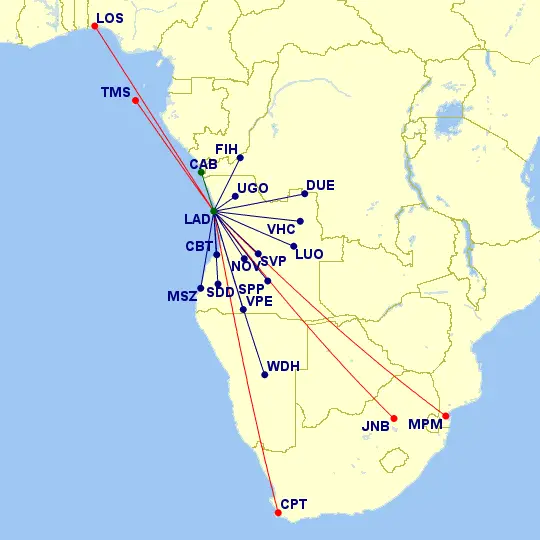
In an interview to Jornal de Angola in 2020, TAAG’s then-CEO Rui Carreira, who now serves as the airline’s non-executive chairman, said that routes like the ones to «Windhoek, Harare, Lusaka, Brazzaville and Kinshasa» would be the ones where the Dash would eventually substitute the 737s.
It’s likely not a coincidence, then, that out of the four destinations that haven’t yet been continued by TAAG post-pandemic, three — Brazzaville, Harare, Lusaka — were the ones mentioned by Carreira back then; in the same interview, he named specifically «Harare and Lusaka» as loss-making that were cancelled even before COVID.
But TAAG has still a long road ahead to reach full utilization; according to Cirium’s Diio Mi, TAAG is down 54.7% in terms of ASKs when comparing July 2022 to July 2019. And remember that, compared to the pre-pandemic, when their short-haul flying was performed (with the exception of some flights with the 777) by four 737s, now its short-haul fleet has four 737 and six Dash 8.
But at the same time this signs asset ociosity, it might also show that the transformative potential of the Dash might only be starting for TAAG. Enter the scene the A220.
Where the A220s enter in this equation
Notice that, over 1000 words into the article, we hadn’t yet talked about the A220s, but this goes to show the level of complexity that’s involved in this industry. In any case, understanding the role of the Dash 8 is important to understand the further developments of TAAG’s short-haul network and fleet.
After all these considerations, let’s leave from this premise: every time a Dash 8 enters the system at TAAG, it «freed» up, either partially or totally, a 737 to fly longer legs, or to reinforce short yet dense routes.
The reality, though, is that TAAG’s 737 are underutilized. While this may happen in function of their higher fuel burn and lower demand post-pandemic in Angola, there are times of the day, especially in the morning, where the three of them (the ones configured for passengers) are flying simultaneously.
Let’s take, for instance, TAAG’s schedule for the morning of Thursday, July 28.

The four flights that leave during the morning, three of which operated by the 737 (Cape Town, Maputo and Johannesburg) are fed by three flights, only one of which (Lagos) is operated by a 737.
This means that — of course, simplifying our assumptions — TAAG would rather leave the two other 737s resting in Luanda than to put them to fly, even if it meant feeding the morning flights. And that’s even if their ownership costs are near to none, as these aircraft are property of TAAG and completely paid for.
The A220 is expected to change this equation completely — even if it will mean paying for their leases. When asked by Aviacionline, a spokesperson for TAAG confirmed they will operate in «domestic [flights], where there is demand, and [with] a direct dedication to regional flights».
According to TAAG in the press release that announced the lease of these new aircraft, the new airplanes will represent a 30% saving in fuels, while a global reduction remains at 20% — a sizeable sum in the razor-thin margins of aviation.
Crucially, this will allow many routes that would eventually be unprofitable with the 737 to be now available for TAAG.
According to the airline, the aircraft will also carry more passengers than the 737-700 (142 instead of 120), thus delivering lower unit cost, and with their performance, «TAAG [will have] the range flexibility to cover the whole intra-African market and intercontinental markets». In other words, flights from Luanda to even outside Africa are not out of the cards with the new aircraft.
Airbus’ announced range of the A220-300 would allow flights to the Brazilian northeast, for instance.
Building a working hub
Considering TAAG’s order is for six A220s and they currently have three 737s, TAAG will thus have to get creative on its network planning department. In order to build a hub that is cohesive as far as connection possibilities go, yet profitable on the bottom line, will be its greatest challenge on the years to come.
Counting on TAAG’s favour is the competition side of the game. Angola’s national carrier has a unique opportunity in that South African Airways, previously the largest hub-and-spoke carrier of Southern Africa, went bust, with its remainingnetwork a fraction of what it was.
It is likely benefitting from such favourable conditions that, according to Angola’s State news agency, ANGOP, TAAG expects to launch flights to Accra even before the A220s arrive. The article also said, citing internal sources from the company, that there would be twenty new routes started by the airline in the next three years.
Paralelly to the new aircraft, expected to start arriving from January 2023, Luanda will have its new airport ready and running by April, according to a statement by President João Lourenço last weekend, says Jornal de Angola. This airport should finally integrate both domestic and international flights under the same roof, something that does not exist in the current terminal, helping to further solidify the hub.
With this new aircraft and infrastructure, then, TAAG will have all the tools required to meet its management’s goal of building a modern, functioning and profitable hub from Luanda. More importantly for its current owner — the Angolan state — it will set the airline up for a privatization that has been talked about for years.
It is not for nothing that TAAG’s press release has lauded the later developements from the airline. «This outstanding outcome validate that the company has restored its international reputation while dealing face-to-face with major stakeholders such as Airbus […] and Air Lease Corporation».
As TAAG’s CEO, Eduardo Fairen Soría, said in the same release, «we are alive, back in business, breaching with the past to achieve greater results and becoming a reference for Africa».

